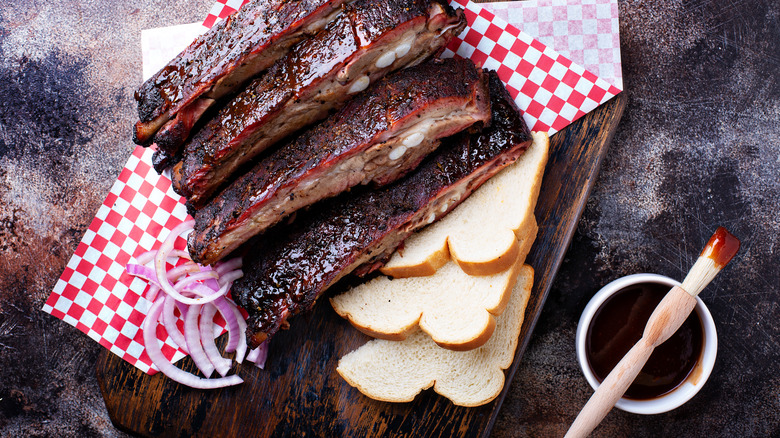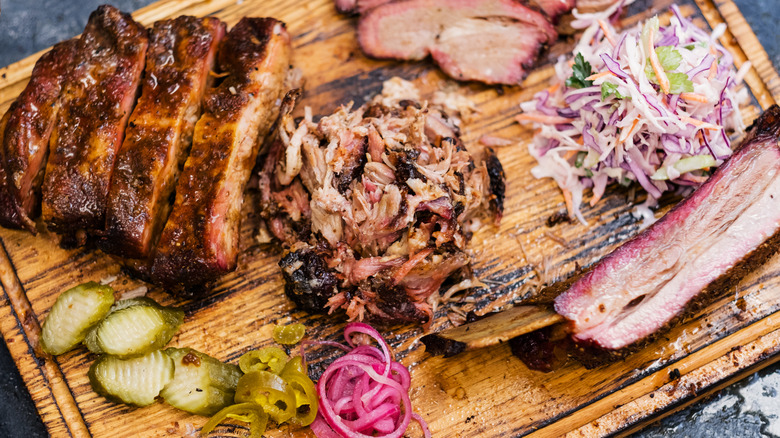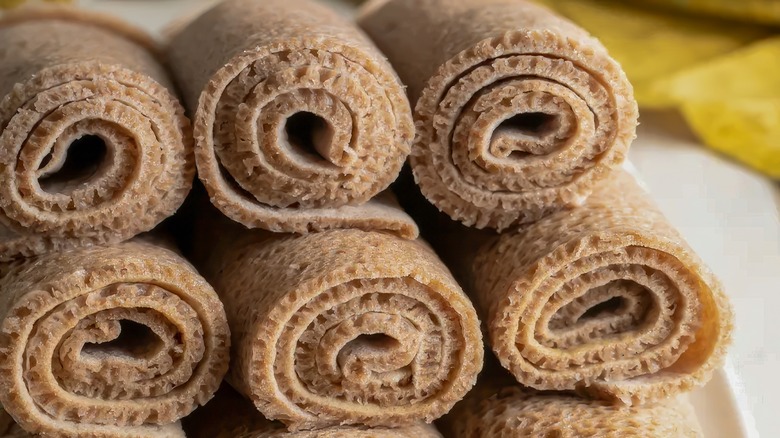How White Bread Became An Essential Southern Barbecue Pairing
Tucked amid the glorious red sauces and glistening browned meats, it's easy to pass over the plain slice or two of white bread that accompanies a tray of barbecue. Despite its ho-hum appearance, the carb is actually loaded down in history. And regardless of how it features in your BBQ plans, the bread's presence is a visual reminder of the meal's humble roots.
Some diners may assume the side is no more than an edible napkin, but many use it to catch grease, mop up sauce, enfold sandwiches, and round out a meal. The tradition traces back to Central Texas barbecue and expanded across the country. Meat markets made the most of their unsold stock by having butchers sell the smoked portions, similar to grocery store rotisserie chickens today.
Stores started pairing smoky pork and beef with white bread because it lasts a long time on the shelf, is wonderfully neutral, filling, and, best of all, cheap. The bread may have also helped fill out an underwhelming plate when customers came in to pick up lunch. Now, it can actually cost restaurants thousands a month to offer such freebies, but it would be sacrilege to do things any other way.
Adding pickles and onion to BBQ
In the Lonestar State, slices of white bread are accompanied by small servings of pickles and sliced raw onion. Similar to the carb, the vegetables were added due to their longevity, availability on the shelf, and ease of preparation. Around 100 years ago, when BBQ was a matter of picking up smoked meats from the butcher rather than dining in at a famed establishment with plenty of prepared sides as we can now, shoppers had to grab what they could to make their version of a plate. The tradition stuck, just like the bread.
The pickles themselves vary from place to place; some barbecue joints opt to brine their own, while others order them in bulk from retailers. Thin sliced raw white onion usually accompanies the tart and salty bites; although some spots prefer to offer sweet pickled red onions. The condiments are usually free, just like the bread, and expected by Texan diners (though disinterested eaters can turn the veggies down).
Although many brisket enthusiasts choose to dig into the meat plain or with a dip of sauce, some see the bread, onion, and pickle trinity as the ideal foundation for a brisket sandwich. The fold-over, as some call it, is an open-faced taco of sorts made using the ingredients. Rather than alternate between fatty meat and sharp vinegar, this handheld bite unites the contrasting components in one bite.
Barbecue's modern bread options
The impact of the white bread side lingers on, as most die-hard BBQ fans know. The wheat offering remains a common addition to many orders across the country and doubles as a tasty foundation when turning leftovers into a brisket breakfast sandwich. However, even though the fluffy slices, or extra thick slices of Texas toast, surged in popularity after the invention of mass-produced sliced bread in the 1920s, other options made appearances on the menu.
Rye bread and cornbread are two sides from decades past that some diners still remember or even prefer. Tangy rye, a staple when eating pastrami sandwiches at a deli, was once offered in certain Texas spots and continues to make limited appearances today. Cornbread is an even simpler mixture to cook up and historically featured another abundant crop in the South. And who could forget saltine crackers, another popular and budget-friendly option still on hand in many of today's stores?
Tortillas and Ethiopian injera, a spongy fermented bread made from teff, also make for a worthy complement to the greasy meal. Both are excellent vessels for dripping sauces and useful when mopping up flavorful bites. Tortillas are nothing new for many Texans, due to the influence of Mexican cooking traditions on the state, but Ethiopian fusion cuisine, which also includes a berbere brisket, offers a fresh direction for the storied side.



